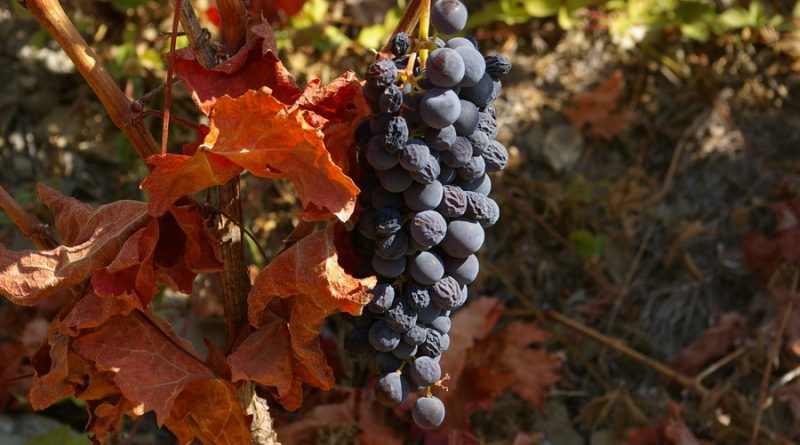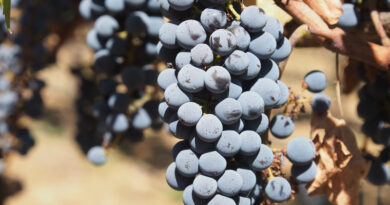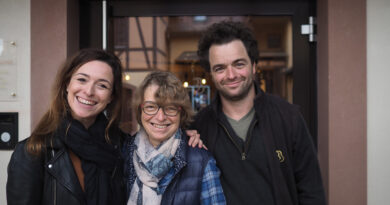Ripeness in wine, part 1
In the first of a three-part series Jamie Goode explores one of the most pressing questions in the world of wine: ripeness and rising alcohol levels
When winemakers work with a light hand, wines have the potential to show a sense of place. Conversely, too much intervention in the winery can obscure the origin of a wine. Examples of this are the use of too much new oak and overextraction. But one of the chief ways in which varietal/regional character can be lost is poor work in the vineyard.
Most of us are familiar with that idea that if grapes are in poor hygienic condition or are picked unripe, or yields are too high, wine quality suffers. Perhaps a more pervasive problem for high-end wines, however, is the current trend to pick ever later, leaving the grapes on the vine until they are super-ripe. This is commonly referred to as “hang time,” and the consequence of this practice is that the resulting wines display a very sweet, lush fruity profile tending towards jamminess, as well as very high alcohol levels. Such wines require substantial tartaric acid additions early in the winemaking process and in some cases undergo later manipulations to reduce alcohol.
A trend of increasing alcohol levels in wine generally has been well documented. This trend is likely to be due to several factors, including the demonstrable climate change that has occurred in wine regions across the globe over the past fifty years. But a key factor has undoubtedly been changing attitudes towards what constitutes ripeness, allied with conscious decisions to pick grapes later. Of course, picking too early is equally detrimental to quality, and in this context, delaying harvest a little—sometimes a decision allied to a fair degree of risk—can be a vital step in getting an extra bit of quality. But the chief problem with ambitious wines these days seems to be that they are made from grapes picked too late.
What are the consequences of high levels of ripeness? Do growers really need to pick so late that they then have to practice highly interventionist winemaking to compensate? What is the chief problem with high alcohol levels, and what can be done in the vineyard and the winery to counter this problem?
THE GRAPE-RIPENING PROCESS
The vine produces grapes in order to reproduce itself sexually. Grapes appeal to birds, and the vine sacrifices some of its resources in order to make it worthwhile for the birds to eat the grapes and thus disperse the seeds over a wide area, with a dollop of fertilizer. After successful flowering and completion of the vine’s sex act, berry development begins. The berries are initially hard and green, camouflaged and rendered unpalatable by bitter-tasting tannins and green-tasting methoxypyrazines, as well as high acid levels. As ripening progresses, sugars begin to accumulate, acid and methoxypyrazine levels fall, and the tannins begin to rearrange themselves chemically such that they taste less astringent. The eventual result is a deliciously sweet, colourful berry that birds find hard to resist. (Initially all grapes would have been “red” grapes, that is, blue black in colour; white grapes are the consequence of a mutation that probably occurred after grapevine domestication.)
In the natural environment of the grapevine, grapes become palatable to birds when the seeds are ready for dispersal, and a visual indicator is provided by the change in colour. [Another aside is needed here. We’re talking here of red varieties, but our discussion applies in some degree also to whites. However, certain characteristics of grapes that are less than fully ripe, such as greenness or herbaceousness, work quite well in some white styles. Bear in mind that most white wines are made with very little skin contact, and thus the tannins in the grape skins, and their state of development aren’t going to be influencing flavour very much.)
But if you were to make a red wine from grapes when they reached the stage at which birds like to eat them, it wouldn’t taste very nice. The acidity would be too high; the grapes, while tasting sweet, wouldn’t have enough sugar to achieve desired levels of alcohol; and the tannins would taste distinctly “green” and astringent. We would certainly choose to let the grapes ripen longer on the vine so that quality wine production would be possible. We’re fussier than the birds. The key issue is how muchlonger.
It is common to divide the grape-ripening process into sugar ripeness and physiological ripeness (also referred to as phenolic or flavour ripeness). The highest goal of viticulture is to achieve this transition in harmony, such that all the processes—sugar accumulation, acid lowering, methoxypyrazine degradation, and tannin softening—all coincide at a suitable harvest date. Of course, in many regions and in many vintages it’s rare for physiological ripeness to occur exactly at the desired sugar ripeness. Given a choice, most winemakers will opt to pick at physiological or flavour ripeness rather than aim for ideal sugar levels in their grapes. This is where winemakers are faced with either living with the consequence of picking at physiological ripeness—elevated alcohol levels—or doing something about it in the winery. If they can, most will opt to achieve this balance in the vineyard by using the viticulturalist’s tool kit. We will say more about this later.
Photosynthesis is the driving force behind ripening. It is the process by which plants harness light energy to produce sugars, which are then transported around the plant via specialized vascular conducting tissue called phloem. The green tissues of a plant are photosynthetic, and these are called source tissues. Tissues at which the sugars are targeted are called sinks. Source-sink relationships are important in the ripening process. In a grapevine in midseason, the two strongest sinks are the growing tips of the shoots and the developing fruit. In a vineyard that has good natural balance, the vigour of the vine will be controlled such that at veraison—the stage in ripening where the grapes change colour, expand, and begin to accumulate sugars—the shoots will have ceased growing, and the fruit will become the predominant sink for the sugars produced during photosynthesis. If the supply of nitrogen and water in a vineyard is too high, it can lead to excessive vigour, which creates several problems. The first is that the large canopies continue growing throughout the ripening process and compete for resources with the fruit. Second, this vigour can also lead to fruit shading, which is usually bad news because the acid balance in the grapes is altered by such shading, and the accumulation of tannins and anthocyanins in the skins is reduced. Third, vigorous growth also creates dense canopies where fungal diseases flourish in the increased humidity that comes from restricted airflow.
The actual factors that govern ripening of grapes are not completely understood at a molecular level, although recent genomic studies have been able to pinpoint the many different genes that are up- or down-regulated (that is switched on to produce specific proteins, or turned off to stop producing proteins) during the ripening process. We know that light has a role. High levels of ultraviolet light, such as those experienced in vineyards at higher altitudes, can increase skin thickness and alter the nature of the tannins in the skins, as well as their quantity. Large diurnal temperature shifts, with cool nights, seems to help preserve acidity in grapes by slowing the process of nighttime respiration in the berries. Latitude has an effect, too: vines grown at higher latitudes experience longer summer day length and therefore photosynthesize longer. In cooler areas, growing seasons are longer because the grapes take longer to mature, and harvest usually occurs in autumn conditions rather than in late summer. Also, in more northerly (northern hemisphere) or southerly (southern hemisphere), daylength fluctuates significantly from the peak of summer to harvest time. Both of these factors could make a difference in the final stages of ripening. Could it be that when ripening finishes in autumnal conditions, it’s grapes can more easily achieve a state at harvest where they show better balance of flavor and sugar? Yields will also affect the ripening process, and while lower yields are generally thought to be good, it could be that ultralow yields encourage too-high ripeness levels.
Temperature is a key factor in ripening. While high temperatures generally accelerate plant growth, once temperatures reach a certain point, the risk of evaporative loss is so high that the vine closes its stomata. Stomata are small gas-exchange pores on the surface of plant tissues that allow carbon dioxide, necessary for photosynthesis, to enter. However, some evaporative water loss (known as transpiration) occurs when they are open, and in hot conditions this loss is high enough to cause the pores to shut and photosynthesis to stop. When applied properly, the techniques of regulated deficit irrigation and partial root drying have been shown to aid grape ripening by altering the vines’ stress-signalling responses in ways that help the fruit. This signalling is done by the plant hormone abscisic acid, and at the right time in the ripening cycle these irrigation techniques, where they are available, can be used to improve grape quality, as well as to save water, because they stimulate abscisic acid production by the roots which then signals to the rest of the plant. It is likely that the best terroirs do this sort of timed water restriction naturally.
There’s an important difference here between cooler and warmer winegrowing regions, which loosely translates to a difference between the Old World and the New World. In classic European wine regions, sugar level has been the usual guide to harvest date, and the higher the sugar levels, the better. Growers are often paid a premium for higher sugar levels because they mean riper grapes and better wine. Once potential alcohol levels reach 12 percent or so, it’s time to pick because physiological ripeness will usually have been achieved. Also, because harvest time coincides with the onset of autumn rains, there is often pressure to get the grapes in as soon as possible. In some cases harvesting occurs at sugar levels that need to be supplemented by chaptalization. The luxury of leaving grapes on the vine until ideal ripening levels are achieved is not always an option in these relatively cool wine regions.
In New World regions, vintage time frequently occurs during settled, warm conditions, and growers can leave the grapes on the vine pretty much as long as they like. Also, because harvest occurs in warmer conditions, sugar levels aren’t a good indicator of physiological ripeness. This can be a problem because sugar is easy to measure in the field, but there are no simple assays of physiological ripeness other than taste. The result is that in these warmer regions, harvesting can occur at very high sugar levels. Acidity is frequently corrected in the winery, so the fall in grape acid levels that occurs with increasing ripeness is not seen as a huge problem.
But with global warming, even the classic European wine regions are finding it difficult to synchronize sugar and physiological ripeness. While warm regions have always had to worry about too-high sugar levels, cooler regions are finding sugars a less reliable indicator of ripening than they used to be and are having to wait for physiological ripeness, which occurs only at sugar levels higher than might be desirable. The consequence is that across the world, alcohol levels have risen. However, the problem is still more acute in the warmer New World regions.
Some of this rise has occurred because growers, quite rightly, have not wanted to have unripe, green characters in their red wines, and they have preferred to have full flavour development in their whites rather than tart, green, rather lean wines. But some of this rise can be attributed to deliberate stylistic choices by winegrowers. They are choosing to wait before picking because they are aiming at wines with a sweeter, lusher fruit profile and softer tannins. Consumer preferences, they argue, have changed. Even at the high end of the market, people want concentrated, dark, sweetly fruited red wines with a new-oak sheen—wines of impact and immediate appeal. After all, this is the style that has appealed so well to influential critics, particularly in the United States. It is widely known as the “international” style of red wine because wines made in this way—with this set of viticultural and winemaking choices—tend to taste rather similar, no matter where they come from. Surmaturité (over-maturity) denies wine typicity.
Sugar content in wine grapes is measured using two scales, depending where you come from. There’s Brix, Baume and Oechsle, which are alternatively used depending on the country. These work on the principle that 90% of the solids in grape juice are sugars, and measuring the density of the must (known as the ‘specific gravity’) gives a good indication of how much sugar is present, and therefore the potential alcohol. 1 degree of Brix equals 10 g/litre of sugar, and 1.8 Brix is equivalent to 1 degree of alcohol in the finished wine. One degree of Baume is roughly equal to 1 degree of alcohol, and this is in turn equal to 7 Oechsle. So, as an example, a level of 12% alcohol will result from grapes being picked at 21.3 Brix (11.9 Baume, 89 Oechsle), and 15% alcohol will result from grapes being picked at 26 Brix (14.4 Baume, 110 Oechsle). Related to sugar accumulation is the loss of acidity that occurs during the ripening process. Acidity is measured in two ways, which don’t correlate exactly. There’s TA, which stands for titratable acidity (for red wines, you’d be aiming at levels of 6-8 g/litre, although it depends on the style), and there’s pH, which measures the hydrogen ions present in the solution (the ideal range for red wines would be 3.4-3.7 in the finished wine, which is slightly lower high than in the must because of the loss of acidity through the malolactic fermentation). In warm climates, acidity is routinely corrected through the addition of tartaric acid, but this can have an impact on flavour, because it can take quite a bit of tartaric acid to shift the pH into a comfortable range. Wines with high pH can taste quite lush and smooth, but there is a large risk of microbial spoilage if the pH is higher. The spoilage yeast Brettanomyces, in particular, thrives at higher pH.
There are other problems in dealing with very ripe grapes. One is that increased sugar ripeness occurs in tandem with decreased yeast-assimilable nitrogen (YAN) levels. Lower YAN levels mean that winemakers have to supplement more, typically by adding the nitrogen source diammonium phosphate (DAP), which can lead to problems because if it is added all at once, it acts like a yeast version of fast food, causing the yeasts to grow rapidly and then struggle. Low YAN is problematic because it leads to reduced protein synthesis and decreased sugar transport into the yeast cell, which can then cause sluggish or incomplete fermentations. It can also lead to problems with the production of hydrogen sulfide, which leads to the wine fault known as reduction. Another problem is that in highly alcoholic wines, potassium is less soluble, which can lead to a problem with tartaric acid falling out of solution during winemaking when it combines with potassium. This compounds the problem that low acidity is already an issue in warm-climate wine made from late-picked grapes, but the high alcohol these wines frequently show causes the acid levels to drop even further. The result of the obsession with tannin ripeness is that the late picking it encourages causes the stability of must and aromatics to become more fragile and runs the risk of losing any sense of typicity. It is as if the wine has become a drug addict, needing more and more supplements and additions to keep it happy.
Acidity problems can also arise through overuse of fruit-zone leaf plucking. While removing the leaves in the fruiting zone has the dual benefit of encouraging air circulation (to reduce the risk of fungal disease) and exposing the bunches to sunlight (this may help reduce levels of methoxypyrazines and allow the fruit to ripen better), it risks causing movement of potassium ions into the fruit. Higher levels of potassium, as we have just mentioned, lead to problems with lower acidity levels in wine. In some warm regions, therefore, some fruit shading may be beneficial. A single wire trellis resulting in umbrella sprawl, commonly found in some Australian regions, may have some wisdom to it. It can also be argued that this is a more “natural” way of trellising a vine than a vertical shoot positioning (VSP) system with leaf-zone plucking. Another viticultural issue of interest here is yield, and related to this vine age (often very old vines have extremely low yields). Sometimes yields can be too low. In warmer years or regions, sometimes larger yields can be better.
In the past, the way of dealing with firm tannic structure in high-end red wines was careful élevage and then time in the bottle. Producers are now worried that consumers and critics won’t have patience with these sorts of wines, and so they join the international-style bandwagon, picking late and then adding acid and a new-oak sheen in the winery. These wines invariably have relatively high alcohol levels because of the decision to aim for higher ripeness.
“Alcohol levels are a vexed question,” agrees Australian wine guru Brian Croser. “The biggest factor is the decision by most winemakers to pick later regardless of the physiological condition of the grapes. There are a lot of wines made from grapes past the use-by date, shrivelled and physiologically dying or dead.” Croser calls this phenomenon “dead grape syndrome” and suggests that it “pertains to the best regions of the table wine world.”
“I heard something recently which absolutely shocked me,” reveals Californian winemaker Randall Grahm: “‘Twenty-eight is the new twenty-four.’ [He was referring to the level of Brix at which grapes are typically harvested.] Wineries are now going for extreme levels of maturity—very popular with certain critics who shall remain nameless—and going back to fix the other elements of the wine, potential alcohol, acidity, and perhaps tannin as well. Certainly, we are now in the realm of the confectioner, rather than the vigneron.”
Ripeness PART 1, PART 2, PART3




